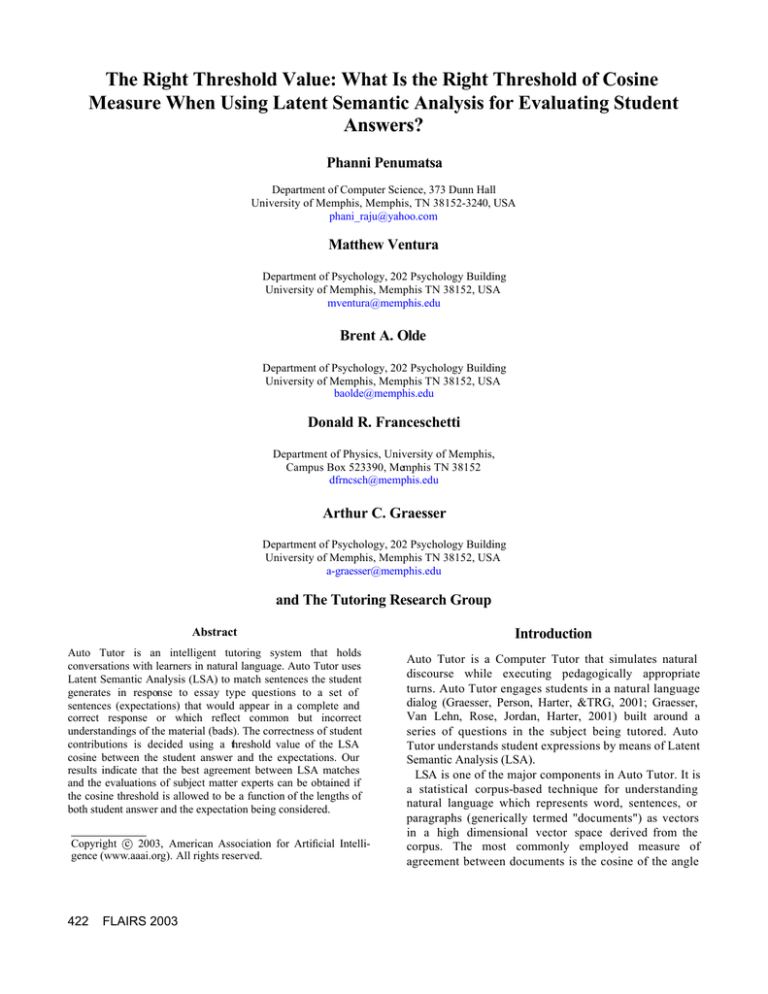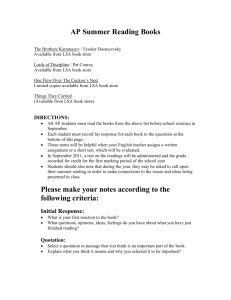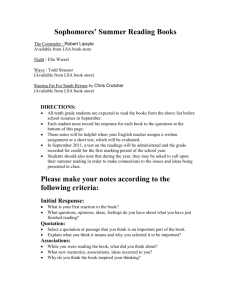
The Right Threshold Value: What Is the Right Threshold of Cosine
Measure When Using Latent Semantic Analysis for Evaluating Student
Answers?
Phanni Penumatsa
Department of Computer Science, 373 Dunn Hall
University of Memphis, Memphis, TN 38152-3240, USA
phani_raju@yahoo.com
Matthew Ventura
Department of Psychology, 202 Psychology Building
University of Memphis, Memphis TN 38152, USA
mventura@memphis.edu
Brent A. Olde
Department of Psychology, 202 Psychology Building
University of Memphis, Memphis TN 38152, USA
baolde@memphis.edu
Donald R. Franceschetti
Department of Physics, University of Memphis,
Campus Box 523390, Memphis TN 38152
dfrncsch@memphis.edu
Arthur C. Graesser
Department of Psychology, 202 Psychology Building
University of Memphis, Memphis TN 38152, USA
a-graesser@memphis.edu
and The Tutoring Research Group
Abstract
Auto Tutor is an intelligent tutoring system that holds
conversations with learners in natural language. Auto Tutor uses
Latent Semantic Analysis (LSA) to match sentences the student
generates in response to essay type questions to a set of
sentences (expectations) that would appear in a complete and
correct response or which reflect common but incorrect
understandings of the material (bads). The correctness of student
contributions is decided using a threshold value of the LSA
cosine between the student answer and the expectations. Our
results indicate that the best agreement between LSA matches
and the evaluations of subject matter experts can be obtained if
the cosine threshold is allowed to be a function of the lengths of
both student answer and the expectation being considered.
c 2003, American Association for Artificial IntelliCopyright °
gence (www.aaai.org). All rights reserved.
422
FLAIRS 2003
Introduction
Auto Tutor is a Computer Tutor that simulates natural
discourse while executing pedagogically appropriate
turns. Auto Tutor engages students in a natural language
dialog (Graesser, Person, Harter, &TRG, 2001; Graesser,
Van Lehn, Rose, Jordan, Harter, 2001) built around a
series of questions in the subject being tutored. Auto
Tutor understands student expressions by means of Latent
Semantic Analysis (LSA).
LSA is one of the major components in Auto Tutor. It is
a statistical corpus-based technique for understanding
natural language which represents word, sentences, or
paragraphs (generically termed "documents") as vectors
in a high dimensional vector space derived from the
corpus. The most commonly employed measure of
agreement between documents is the cosine of the angle
between the corresponding vectors (Kintch, 1998;
Landauer and Dumais, 1997; Landauer, Foltz and
Latham,1998).
The present study focuses on the appropriate cosine
threshold value for declaring agreement in a tutoring
situation. In Auto Tutor 2.0 for conceptual physics we
declared a match whenever a cosine greater than 0.65 was
found between the students answer and the expectation
with which it was compared. Had a higher value been
used, fewer matches would be found and the students
would have been prodded to revise their Answer more
often. This would lead to student frustration if the answer
were in fact correct but merely phrased differently from
the expectation. Further a length effect might be expected.
The probability of two longer documents scoring a high
cosine match by accident would not necessarily be the
same as that for two shorter documents. To determine
whether such a length effect could exist we compared the
consistency of LSA cosine-based ratings with those of
human experts for short, medium and longer length
documents.
The following sections reprise LSA and AT separately.
We then report results of our document length study.
Latent Semantic Analysis
LSA is a statistical corpus-based text comparison
technique that was originally developed for text retrieval.
Nowadays it is more often used to capture the content of
large bodies of texts (Kintsch, 1998; Landauer & Dumais,
1997; Landauer Foltz and Laham, 1998). LSA has been
tested in the grading of essays (Foltz, Gilliam & Kendall,
2000) and found to assign grades consistent with the
judgment of experts in composition.
LSA begins with a corpus, a body of documents,
generally derived from published texts or reference
works. The documents can be individual sentences or
paragraphs, or some other convenient unit. From this is
constructed a rectangular matrix, with one row for each
distinct word in the text and one column for each
document. The matrix elements may then be subjected to
a mathematical weighting process based on the frequency
of occurrence of the words in the document or in the
English language as a whole (Berry, Dumais &O'Brien,
1995). The resulting matrix is then subjected to a singular
value decomposition (SVD), by which it is expressed as
the product of three matrices, the second of which is
diagonal with the singular values appearing in decreasing
order. For the purposes of latent semantic analysis, all but
the N largest diagonal elements are then set equal to zero
and the matrices are re-multiplied. The N chosen is
typically of the order of a few hundred. This process is
thought to eliminate aspects of word use in the text which
are incidental to the expression of meaning but to
preserve correlations between words that capture
meanings expressed in the text.
Once a corpus has been constructed and the
corresponding word-document matrix is transformed as
outlined above, one can represent any combination of
words in the corpus as vector by forming a linear
combination of the rows representing the component
words. For any pair of word combinations, then, there will
be two vectors in the abstract N-dimensional space
defined by the (SVD) which meet at an angle, the cosine
of which is readily calculated from the vector "dot
product," the sum of the pair-wise products of the N
components.
LSA Cosine values successfully predict the coherence
of successive sentences in a text (Foltz, Kintsch and
Landauer, 1998), the similarity between student answers
and ideal answers to questions (Graesser, P. WiemerHastings et al, 2000) and the structural distance between
nodes in conceptual graph structures (Graesser, Karnavat,
Pomeroy, P. Wiemer-Hastings &TRG, 2000). At this
point researchers are exploring the strengths and
limitations of LSA in representing world knowledge.
LSA Use in Auto Tutor
A thorough description of the Auto Tutor is provided in
Graesser et al (1999) and Graesser, Person, Harter and
TRG (2001). We provide only a general overview here.
Auto Tutor's style of tutoring is modeled after actual
human tutoring strategies (Graesser, Pearson and
Magliano, 1955). The tutor starts out by asking a question
or posing a problem that requires a paragraph length
answer. The tutor then works with the student to revise
the paragraph until it covers the essential points
(expectations) that the tutor deems constitute a correct and
complete answer (Olde et al, 2002). Once a question has
been satisfactorily answered the tutor poses the next
question.
Auto Tutor's general knowledge of its tutoring domain
resides in the corpus of texts from which the LSA vector
space has been constructed, while the expectations,
probable bad answers, and repertoire of dialog moves for
each question are contained in separate curriculum scripts.
The main dialog moves available to Auto Tutor are hints,
pumps and assertions. There are a variety of additional
dialog moves in the curriculum script that need not be
addressed in the present study. (Olde et al, 2002;
Graesser, Person, Harter, 2001)
Auto Tutor matches student responses to the
expectations and probable bad answers for each question
by calculating the LSA cosine between them. Based on
the computed cosines, Auto Tutor selects its next dialog
move which might include positive, negative of neutral
feed back, pumps for additional information, a prompt for
specific words, a hint, assertion, summary, correction or a
follow-up question. The smoothness of the mixed
initiative dialog in Auto Tutor critically depends on the
FLAIRS 2003
423
validity of this cosine matching procedure. This motivated
us to look closer at the LSA cosine matches.
Data Collection Methods
content of the expectation, even though it could not be
identified in the written answer. The agreement between
LSA and the experts was studied as a function of student
answer length and expectation length so as to gauge the
impact of these two variables on the agreement.
Participants
Participants were 24 students from the University of
Memphis, Rhodes College and University of Pittsburgh
who had previously taken a physics course. Each
participant answered 8 problems and the answers were
rated by two physics experts in terms of covering
expectations of that problem.
Questions and Answers
The data used in the present experiment came from
answers to conceptual physics problems. The physics
problem answers were graded by LSA, using the space
reported in Franceschetti et al. (2001). For each problem,
there were sets of expectations to compare to the student
answers. We judged the quality of each student’s answer
by calculating the LSA cosine between each expectation
for a problem and all possible combinations of sentences
the student gave for this expectation. This gave us a
distribution of LSA cosine scores for each expectation.
The fact that we considered all combinations of student
sentences and taking the maximum LSA values had the
intent of biasing assessment of student contributions
towards correctness. We then took the highest cosine
match for each expectation, and compared such values to
expert physics tutors. The cosines matches were then
compared with the subjective judgments of two expert
physics tutors who read each student answer and for each
expectation decided whether the expectation was
explicitly present, implicitly present, or absent. The
"implicitly present" category was used when the grader
felt that it was probable that the student understood the
424
FLAIRS 2003
Results and Discussion
The results of our study are summarized in Figure1 and
Figure2. Qualitatively there is a clear correlation of the
mean maximum LSA cosine and the experts' opinion that
an expectation was covered by an answer. Interestingly,
this is so even for those cases in which the expert
classified the expectation as "implicitly" present, that is
not directly stated or paraphrased by the student. This
finding is consistent with the notion that LSA in some
sense captures the meanings or ideas expressed in the
corpus from which it is constructed.
Quantitatively, the average cosine between expectations
and student responses that the experts rated as explicitly
expressing them was 0.42. This is surprisingly low
compared to the current threshold used in AutoTutor
(.65). Additionally, expectation length and sentence
length significantly contribute to changing the cosine
value under the levels of expert ratings. This suggests
that not only should the threshold value be lowered, it
should vary according to length of expectation and length
of sentence contribution.
.5
Cosine
.4
Expectation Length
.3
low
medium
.2
high
Not Present
Implicit
Present
Consensus of Rater Coding
Figure 1.
.5
Cosine
.4
Number of Sentences
.3
low
medium
.2
high
Not Present
Implicit
Present
Consensus of Rater Coding
Figure 2
FLAIRS 2003
425
Figures 1 and 2 show the effect of expectation
length and student contribution length over
maximum cosine value that correlates with
expert ratings. We obviously need to adjust the
threshold of cosine value according to the
expectation length and student length. Currently
we are working on a mathematical model that
can dynamically adjust the threshold of cosine
value according to the length of expectation and
length student contribution. We are currently
implementing this mathematical model in the
next upcoming version of the AutoTutor
(AutoTutor 3.0).
Acknowledgments. This research was supported
by grants from DoD Multidisciplinary University
Research
Initiative
(MURI)
program
administered by the Office of Naval Research
(N00014-00-1-0600) and the National Science
Foundation (SBR 9720314 and REC 0106965).
Any opinions, findings, and conclusions or
recommendations expressed in this material are
those of the authors and do not necessarily
reflect the views of ONR or NSF.
References
Berry,M. W., Dumais, S.T., & O’Brien,
G.W.(1995), Using Linear algebra for intelligent
information retrieval. SIAM Review, 37,573595.
Foltz,
W.,Gilliam,
S.,&
Kendall,S.(2000).
Supporting content based feedback in on-line
writing evaluation with LSA. Interactive
Learning Environments, 8,111-128.
Foltz, P.W.,Kintsch, W., & Landauer, T. K,
(1998). The measurement of textual coherence
with Latent semantic analysis . Discourse
Processes 25, 285-307
Franceschetti, D. R., Karnavat, A., Marineau,
J., Mccallie, G. L., Olde, B., Terry, B. L.,
Graesser, A (2001), Development of Physics
Text Corpora for Latent Semantic Analysis,
Procedings of the 23 rd Annual Conference of
the Cognitive Science Society (pp. 297-300)
Mahwah NJ, Erlbaum.
Graesser,A.C., Karnavat, A., Pomeroy, A.,
Wiemer-Hastings , K., & TRG (2000), Latent
Semantic Analysis captures casual, goaloriented, an taxonomic structures . Proceedings
of the 22 nd Annual Conference of the Cognitive
Science Society (pp. 184-189) Mahwah, NJ:
Erlbaum
Graesser, A. C., Person, N., Harter, D., & TRG
(2001). Teaching tactics and dialog in
426
FLAIRS 2003
AutoTutor. International Journal of Artificial
Intelligence in Education, 12, 257-279.
Graesser , A.C., N.K.,& Magliano, J.P. (1995 ).
Collaborative dialogue patterns in naturalistic
one –to-one tutoring. Applied Cognitive
Psychology, 9, 359.1-28.
Graesser, A., VanLehn, K., Rose, C., Jordan. P.,
and Harter, D. (2001). Intelligent tutoring
systems with coversational dialogue. AI
Magazine, 22, 39-51.
Graesser, A.C., Wiemer-Hastings, P., WiemerHastings, K., Harter, D., & Person, N., and the
TRG (2000). Using latent semantic analysis to
evaluate the contributions of students in
AutoTutor. Interactive Learning Environments,
8, 128-148.
Kintsch, W.(1998). Comprehension : A
paradigm for cognition . Cambridge, MA:
Cambridge University Press.
Landauer, T. K., & Dumais, S. T. (1997) A
solution to Plato’s problem: The latent semantic
analysis theory of acquisition, induction, and
representation of knowledge. Psychological
Review , 104, 211-240.
Landauer, T. K., Foltz, P. W., & Laham, D.
(1998). An introduction to latent semantic
analysis. Discourse processes 25, 259-284.
Olde, B. A., Franceschetti, D.R., Karnavat,
Graesser, A. C. & the Tutoring Research Group
(2002). The right stuff: Do you need to sanitize
your corpus when using Latent Semantic
Analysis? Proceedings of the 24th Annual
Meeting of the Cognitive Science Society (pp.
708-713). Mahwah, NJ: Erlbaum.
Wiemer-Hastings P., Graesser, A.C., Hater,
D.,and the Tutoring Research group (1998). The
foundations and architecture of Autotutor.
Proceedings of the 4th International Conference
on Intelligent Tutoring Systems (pp. 334-343).
Berlin, Germany: Springer-Verlag.
Weimer-Hastings, P., Weimer-Hastings, K.,
Graesser, A. &TRG (1999). Improving an
intelligent tutor’s comprehension of students
with latent semantic analysis. In S.Lajoie
&M.Vivet(Eds.),
Artificial
intelligence
in
education (pp. 535-542). Amsterdam: IOS Press.




